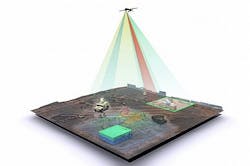Officials of the U.S. Defense Advanced Research Projects Agency (DARPA) in Arlington, Va., have awarded contracts to DRS Network & Imaging Systems LLC in Melbourne, Fla.; Voxtel Inc. in Beaverton, Ore.; The BAE Systems Electronic Systems segment in Merrimack, N.H.; and the Lockheed Martin Corp. Missiles and Fire Control segment in Orlando, Fla., for the Reconfigurable Imaging (ReImagine) program.
ReImagine seeks to develop a software-reconfigurable, multi-mode imaging system with functions not normally accessible within one focal plane array: configurable regions-of-interest that not only operate independently of other regions of the array, but also that reconfigure the array's measurements in response to the scene.
The idea is to develop an imaging focal plane array that can adapt to different conditions and operating modes to collect the most valuable information in the scene. The focal plane array on the ReImagine imaging sensor would function similarly to a field-programmable gate array (FPGA) processor by using several modes of imaging that may be defined after the array has been designed.
Lockheed Martin won a potential $10.2 million ReImagine contract on 30 May; DRS won a potential $10.1 million contract on 5 June; BAE Systems won a potential $7.5 million contract on 1 June, and Voxtel won a potential $5.2 million contract on 30 May.
Related: A camera that can see unlike any imager before it
These contractors also will try to develop algorithms that learn to collect the most valuable information when the sensor can be configured for a variety of measurements. 3-D integration may enable the ReImagine sensor to interface with virtually any type of imaging sensor, such as photodiode, photoconductor, avalanche photodiode, or bolometer.
Reconfigurable capability also could enable users to optimize this imaging sensor for any spectral band, such as ultraviolet (UV) through very long-wave infrared (VLWIR). Separate regions of the focal plane array could run separately at high resolution, or at high frame rate.
In this way the sensor could perform real-time analysis on much more complex scenes than traditional systems to produce more actionable information to the warfighter than ever has been possible from a single imaging sensor, DARPA officials say.
An imaging system that autonomously extracts the most relevant information with one sensor, and based only on the context in the scene, would revolutionize a wide variety of military and commercial applications, experts say. A software-configurable array that enables simultaneous and distinct imaging modes in different regions of interest might be able to do this.
The DARPA ReImagine program has three technical areas: single or multi-color passive imager architecture and algorithms; hybrid active/passive imager architecture and algorithms; and concepts for imaging systems with internal feedback.
The first technical area seeks to design a single- or multi-color passive camera that works in spectral bands ranging from ultraviolet to very long-wave infrared.
The second technical area seeks to design a hybrid active/passive imager architecture, where passive mode operation is based on traditional intensity measurements across an image array, and active mode is based on time-of-flight (TOF) measurements for 3-D range information such as from laser radar. The third technical area seeks to develop adaptive algorithms for reconfigurable imaging systems.
For more information contact DRS Network & Imaging Systems online at www.leonardodrs.com/locations/drs-network-imaging-systems-llc-melbourne-fl; Voxtel at http://voxtel-inc.com; BAE Systems Electronic Systems at www.baesystems.com; Lockheed Martin Missiles and Fire Control at www.lockheedmartin.com/us/mfc.html; or DARPA at www.darpa.mil.
Learn more: search the Aerospace & Defense Buyer's Guide for companies, new products, press releases, and videos



